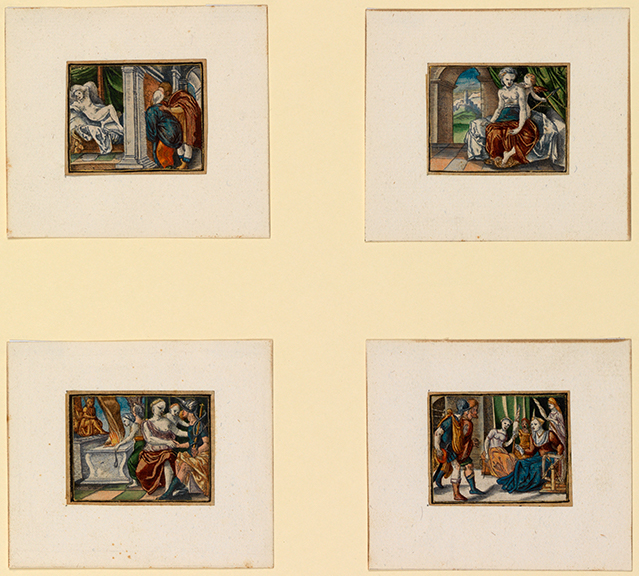Four Allegoric Scenes of Women from the Antiquity c.1550-1600
Georg Mack the Elder, attributed
ca. 1556 -1601
Illuminated woodcuts laid on a 17th century album sheet. Size of each sheet: from 6.3 x 4.9 cm to 6.3 x 5.1 cm.
The first image representing a nude woman being spied in her bedroom by two men watching through a curtain could represent the episode taken from Herodote when King Candaule asks his chamber aid Gyges to spy on his wife the queen to realise how beautiful she is.
Following the image of a nude woman with a child holding an arrow is most probably a representation of Cupid and Psyche.
The one featuring Mercury talking to a semi nude woman, with a young woman at the back lighting a bonfire in a temple, could be a representation of Virgil’s History of Aenea and Dido. Aenea was pushed by Juno and Psyche to visit the city of Carthage built by the Queen Dido on his way to Italy. They fell in love, but Jupiter asked Mercury to remind Aenea of his war mission in order to destroy Juno’s scheme. Respecting his god’s command, Aenea left Carthage during the night without saying goodbye. Dido was heartbroken, and she asked a servant to lighten a funerary bonfire. Stabbing herself, she jumped into the flames. Aenea, admiring the bonfire from the sea, had no idea of what was happening in front of his eyes. The picture could be a visual summary of such episode, with Juno and Mercury at the foreground, and Dido crying in front of the bonfire in the background.
The last image relates to the theme of the spinster, and emblem of feminine virtue at work since the antiquity. It could relate to either the history of Arachne or that of Ulysse and Penelope.
Examples of feminine good conduct based on famous women from the antiquity or from the Gospels became popular in the literature from the 14th to the 16th century. All in all those iconographies appear to be related to this new literature genre.
Georg Mack the Elder was a print colourist from one of the major colourist dynasties of Briefmaler and Illuministenactive in Nuremberg between the 16th and the early 17th century.
£ 3,000.-
